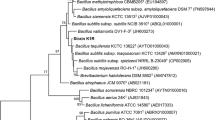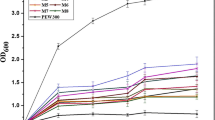Abstract
A recombinant version of the AGAAN antimicrobial peptide (rAGAAN) was cloned, expressed, and purified in this study. Its antibacterial potency and stability in harsh environments were thoroughly investigated. A 15 kDa soluble rAGAAN was effectively expressed in E. coli. The purified rAGAAN exhibited a broad antibacterial spectrum and was efficacious against seven Gram-positive and Gram-negative bacteria. The minimal inhibitory concentration (MIC) of rAGAAN against the growth of M. luteus (TISTR 745) was as low as 60 µg/ml. Membrane permeation assay reveals that the integrity of the bacterial envelope is compromised. In addition, rAGAAN was resistant to temperature shock and maintained a high degree of stability throughout a reasonably extensive pH range. The bactericidal activity of rAGAAN ranged from 36.26 to 79.22% in the presence of pepsin and Bacillus proteases. Lower bile salt concentrations had no significant effect on the function of the peptide, whereas higher concentrations induced E. coli resistance. Additionally, rAGAAN exhibited minimal hemolytic activity against red blood cells. This study indicated that rAGAAN may be produced on a large scale in E. coli and that it had an excellent antibacterial activity and sufficient stability. This first work to express biologically active rAGAAN in E. coli yielded 8.01 mg/ml at 16 °C/150 rpm for 18 h in Luria Bertani (LB) medium supplemented with 1% glucose and induced with 0.5 mM IPTG. It also assesses the interfering factors that influence the activity of the peptide, demonstrating its potential for research and therapy of multidrug-resistant bacterial infections.






Similar content being viewed by others
Data availability
All the data has been presented in the paper and any additional information will be available on request.
Abbreviations
- MIC:
-
Minimum Inhibitory Concentration
- PI:
-
Propidium Iodide
- MHB:
-
Mueller Hinton Broth
- IPTG:
-
Isopropyl-1-thio-β-D-galactopyranoside
- LC–MS/MS:
-
Liquid chromatography-tandem mass spectrometry
- SDS:
-
PAGE – Sodium dodecyl Sulphate–Polyacrylamide Gel Electrophoresis
- KDa:
-
Kilo Dalton
References
Ajingi YS, Muhammad A, Khunrae P, Rattanarojpong T, Pattanapanyasat K, Sutthibutpong T, Jongruja N (2021) Antibacterial potential of a novel peptide from the consensus sequence of dermaseptin related peptides secreted by Agalychnis annae. Curr Pharm Biotech 22:1216–1227. https://doi.org/10.2174/1389201021666201020161428
Alfei S, Piatti G, Caviglia D, Schito GC, Zuccari G, Schito AM (2022) Biocidal cationic macromolecules irrespective of bacterial resistance: our best achievements. Med Sci Forum 7:10. https://doi.org/10.3390/ecms2021-10833
Almaaytah A, Mohammed GK, Abualhaijaa A, Al-Balas Q (2017) Development of novel ultrashort antimicrobial peptide nanoparticles with potent antimicrobial and antibiofilm activities against multidrug-resistant bacteria. Drug Design Dev Ther 11:3159. https://doi.org/10.2147/DDDT.S147450
Barran G, Kolodziejek J, Coquet L, Leprince J, Jouenne T, Nowotny N, Conlon JM, Mechkarska M (2020) Peptidomic analysis of skin secretions of the caribbean frogs leptodactylus insularum and leptodactylus nesiotus (leptodactylidae) identifies an ocellatin with broad spectrum antimicrobial activity. Antibiotics. https://doi.org/10.3390/antibiotics9100718
Chandran C, Tham HY, Rahim RA, Lim SHE, Yusoff K, Song AA-L (2022) Lactococcus lactis secreting phage lysins as a potential antimicrobial against multi-drug resistant Staphylococcus aureus. PeerJ 10:e12648. https://doi.org/10.7717/peerj.12648
Cardoso MH, Ribeiro SM, Nolasco DO, De La Fuente-Núñez C, Felício MR, Gonçalves S, Matos CO, Liao LM, Santos NC, Hancock REW, Franco OL, Migliolo L (2016) A polyalanine peptide derived from polar fish with anti-infectious activities OPEN. Publ. Gr, Nat. https://doi.org/10.1038/srep21385
Chen Y, Wu J, Cheng H, Dai Y, Wang Y, Yang H, Xiong F, Xu W, Wei L (2020) Anti-infective effects of a fish-derived antimicrobial peptide against drug-resistant bacteria and its synergistic effects with antibiotic. Front Microb 11:602412. https://doi.org/10.3389/fmicb.2020.602412
Dash R, Bhattacharjya S (2021) Thanatin: an emerging host defense antimicrobial peptide with multiple modes of action. Int J Mol Sci 22:1–13. https://doi.org/10.3390/ijms22041522
Deptuła M, Wardowska A, Dzierżyńska M, Rodziewicz-Motowidło S, Pikuła M (2018) Antibacterial peptides in dermatology–strategies for evaluation of allergic potential. Molec 23:414. https://doi.org/10.3390/molecules23020414
Dyo YM, Purton S (2018) The algal chloroplast as a synthetic biology platform for production of therapeutic proteins. Microbiology 164:113–121. https://doi.org/10.1099/mic.0.000599
Eade CR, Hung CC, Bullard B, Gonzalez-Escobedo G, Gunn JS, Altiera C (2016) Bile acids function synergistically to repress invasion gene expression in salmonella by destabilizing the invasion regulator hilD. Infect Immunity 84:2198–2208. https://doi.org/10.1128/IAI.00177-16
Gadishaw-Lue C, Banaag A, Birstonas S, Francis A-S, Foster DB, Kus JV, Gebremedhin A, Dang V, Tran SL, Serbanescu A, Barnett D (2021) Bile salts differentially enhance resistance of enterohemorrhagic Escherichia coli O157:H7 to host defense peptides. J Bacteriol 193:4509–4515. https://doi.org/10.1128/JB.00200-11
Gasteiger E, Hoogland C, Gattiker A, Wilkins MR, Appel RD, Bairoch A et al (2005) Protein identification and analysis tools on the ExPASy server. In: Min H (ed) The proteomics protocols handbook. Human Press, pp 571–607
Havlik D, Brandt U, Bohle K, Fleißner A (2017) Establishment of Neurospora crassa as a host for heterologous protein production using a human antibody fragment as a model product. Microb Cell Fact 16:128. https://doi.org/10.1186/s12934-017-0734-5
Jodoin J, Hincke MT (2018) Histone H5 is a potent antimicrobial agent and a template for novel antimicrobial peptides. Sci Rep 8(1):1–15. https://doi.org/10.1038/s41598-018-20912-1
Johanna Toro Segovia L, Alberto Tellez Ramírez G, Carolina Henao Arias D, David Rivera Duran J, Pablo Bedoya J, Carlos Castano Osorio J (2017) Identification and characterization of novel cecropins from the Oxysternon conspicillatum neotropic dung beetle. PLoS ONE. https://doi.org/10.1371/journal.pone.0187914
Klubthawee N, Aunpad R (2021) A thermostable, modified cathelicidin-derived peptide with enhanced membrane-active activity against Salmonella enterica serovar Typhimurium. Front Microbiol. https://doi.org/10.3389/fmicb.2020.592220
Kunwar CB, Birstonas S, McPhee JB, Foster DB (2020) Molecular basis of bile-salt-and iron-induced enterohaemorrhagic E. coli resistance to cationic antimicrobial peptides. Microbiology (united Kingdom) 166:1149–1159. https://doi.org/10.1099/mic.0.000988
Le LTM, Nyengaard JR, Golas MM, Sander B (2018) Vectors for expression of signal peptide-dependent proteins in baculovirus/insect cell systems and their application to expression and purification of the high-affinity immunoglobulin gamma Fc receptor I in complex with its gamma chain. Mol Biotech 60:31–40. https://doi.org/10.1007/s12033-017-0041-8
Lekshmipriya P, Vineethkumar TV, Joseph J, Asha R, Thomas S, George S (2021) Synergistic effect of frog skin antimicrobial peptides in combination with antibiotics against multi host gram-negative pathogens. Int J Pept Res Ther 27:1529–1540. https://doi.org/10.1007/s10989-021-10189-w
Li J, Hu S, Jian W, Xie C, Yang X (2021) Plant antimicrobial peptides: structures, functions, and applications. Bot Stud 62:1–15. https://doi.org/10.1186/s40529-021-00312-x
Magaña-Ortiz D, Fernández F, Loske AM, Gómez-Lim MA (2018) Extracellular expression in Aspergillus niger of an antibody fused to Leishmania sp. antigens. Curr Microb 75:40–48. https://doi.org/10.1007/s00284-017-1348-1
Mantravadi PK, Kalesh KA, Dobson RCJ, Hudson AO, Parthasarathy A (2019) Antibiotics the quest for novel antimicrobial compounds: emerging trends in research, development, and technologies. Antibio 8:8. https://doi.org/10.3390/antibiotics8010008
Mardirossian M, Barrière Q, Timchenko T, Müller C, Pacor S, Mergaert P, Scocchi M, Wilsona DN (2018) Fragments of the nonlytic proline-rich antimicrobial peptide Bac5 kill Escherichia coli cells by inhibiting protein synthesis. Antimic Agt and Chem 62:8. https://doi.org/10.1128/AAC.00534-18
Mookherjee N, Anderson MA, Haagsman HP, Davidson DJ (2020) Antimicrobial host defence peptides: functions and clinical potential. Nat Res. https://doi.org/10.1038/s41573-019-0058-8
Nakamura I, Yoshimura S, Masaki T, Takase S, Ohsumi K, Hashimoto M, Furukawa S, Fujie A (2017) ASP2397: a novel antifungal agent produced by Acremonium persicinum MF-347833. J Antibiot 70:45–51. https://doi.org/10.1038/ja.2016.107
Ning HQ, Li YQ, Tian QW, Wang ZS, Mo HZ (2019) The apoptosis of Staphylococcus aureus induced by glycinin basic peptide through ROS oxidative stress response. LWT 99:62–68. https://doi.org/10.1016/j.lwt.2018.09.028
Pantic JM, Jovanovic IP, Radosavljevic GD, Arsenijevic NN, Conlon JM, Lukic ML (2017) The potential of frog skin-derived peptides for development into therapeutically-valuable immunomodulatory agents. Molecules 22(12):2071. https://doi.org/10.3390/molecules22122071
Pumbwe L, Skilbeck CA, Nakano V, Avila-Campos MJ, Piazza RMF, Wexler HM (2007) Bile salts enhance bacterial co-aggregation, bacterial-intestinal epithelial cell adhesion, biofilm formation and antimicrobial resistance of Bacteroides fragilis. Micr Pathog 43(2):78–87. https://doi.org/10.1016/j.micpath.2007.04.002
Retzl B, Hellinger R, Muratspahic EM, Pinto MEF, Bolzani VS, Gruber CW (2020) Discovery of a beetroot protease inhibitor to identify and classify plant-derived cystine knot peptides. J Nat Prod 2020:3305–3314. https://doi.org/10.1021/acs.jnatprod.0c00648
Sittipol D, Rodpan S, Ajingi YS, Lohnoo T, Lerksuthirat T, Kumsang Y, Yingyong W, Khunrae P, Rattanarojpong T, Pattanapanyasat K, Jongruja N (2021) Identification, overexpression, purification, and biochemical characterization of a novel hyperthermostable keratinase from Geoglobus acetivorans. 3 Biotech. https://doi.org/10.1007/s13205-020-02538-1
Szczesna K. Why does the molecular weight of my protein differ from the theoretically expected weight? | Technology Networks [WWW Document]. URL https://www.technologynetworks.com/proteomics/articles/why-does-the-molecular-weight-of-my-protein-differ-from-the-theoretically-expected-weight-322079. Accessed 25 Jan 2023
Varga JFA, Bui-Marinos MP, Katzenback BA (2019) Frog skin innate immune defences: sensing and surviving pathogens. Front Immunol 9:3128. https://doi.org/10.3389/fimmu.2018.03128
Wang DY, van der Mei HC, Ren Y, Busscher HJ, Shi L (2020) Lipid-based antimicrobial delivery-systems for the treatment of bacterial infections. Front Chem. https://doi.org/10.3389/fchem.2019.00872
Wei X-B, Wu R-J, Si D-Y, Liao X-D, Zhang L-L, Zhang R-J (2016) Novel hybrid peptide cecropin A (1–8)-LL37 (17–30) with potential antibacterial activity. Int J Mol Sci 17(7):983. https://doi.org/10.3390/ijms17070983
Wei X, Wu R, Zhang L, Ahmad B, Si D, Zhang R (2018) Expression, purification, and characterization of a novel hybrid peptide with potent antibacterial activity. Molecules 23:6. https://doi.org/10.3390/molecules23061491
Zhao GP, Li YQ, Sun GJ, Mo HZ (2017) Antibacterial actions of glycinin basic peptide against Escherichia coli. J Agric Food Chem 65(25):5173–5180. https://doi.org/10.1021/acs.jafc.7b02295
Acknowledgements
This research was supported by King Mongkut’s University of Technology Thonburi’s Postdoctoral Fellowship.
Funding
Funding from Research, Innovation and Partnerships Office, King Mongkut’s University of Technology Thonburi, KMUTT.
Author information
Authors and Affiliations
Contributions
YSA performed the experiments and original draft of the manuscript. NR assisted in performing the experiments. NUJ proofread the manuscript and provide technical writing assistance. YK data curation, conceptualization, and discussion. NJ funding acquisition, methodology, data curation and supervision.
Corresponding author
Ethics declarations
Conflict of interest
The authors declare that they have no conflict of interest in the publication.
Ethical approval
This article does not contain any studies with human participants or animals performed by any of the authors.
Rights and permissions
Springer Nature or its licensor (e.g. a society or other partner) holds exclusive rights to this article under a publishing agreement with the author(s) or other rightsholder(s); author self-archiving of the accepted manuscript version of this article is solely governed by the terms of such publishing agreement and applicable law.
About this article
Cite this article
Ajingi, Y.S., Rukying, N., Jiddah, N.U. et al. Cloning, recombinant expression, purification, and functional characterization of AGAAN antibacterial peptide. 3 Biotech 13, 88 (2023). https://doi.org/10.1007/s13205-023-03512-3
Received:
Accepted:
Published:
DOI: https://doi.org/10.1007/s13205-023-03512-3




